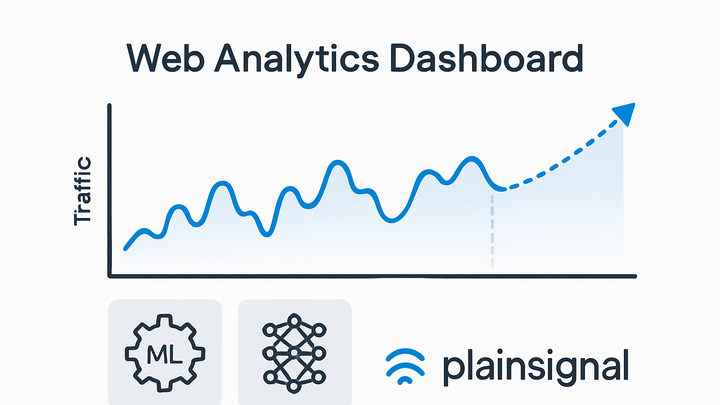Published on 2025-06-22T04:32:55Z
What is Predictive Analytics? Examples for Analytics Industry
Predictive Analytics is a branch of advanced analytics that uses historical data, statistical algorithms, and machine learning techniques to forecast future outcomes and trends. In the context of web analytics, it helps businesses anticipate user behavior such as traffic volume, conversion rates, and potential churn. By modeling patterns in past interactions, predictive analytics enables teams to make data-driven decisions, optimize marketing campaigns, and personalize user experiences before key events occur. SaaS platforms like PlainSignal and Google Analytics 4 (GA4) offer built-in predictive metrics and APIs to streamline implementation. Predictive analytics pipelines typically involve collecting clean, relevant data, engineering meaningful features, training and validating models, and deploying these models into production dashboards. As organizations increasingly rely on forward-looking insights, mastering predictive analytics becomes essential for staying competitive in the digital landscape.
Predictive analytics
Use statistical models and machine learning on historical web data to forecast future user behaviors and trends.
Introduction
An overview of what predictive analytics means in web analytics and why it matters for digital teams.
-
Definition
Predictive analytics uses statistical models and machine learning to analyze past data and predict future outcomes.
-
Value proposition
It empowers marketers and product teams to anticipate user needs, allocate budgets more effectively, and minimize churn.
How Predictive Analytics Works
A breakdown of the typical stages in a predictive analytics workflow, from raw data to actionable forecasts.
-
Data collection and preparation
Gather historical web traffic, event, and user data, then clean and format it for analysis.
-
Sources
Data can come from PlainSignal, GA4, CRM systems, and marketing platforms.
-
Cleaning and preprocessing
Handle missing values, normalize metrics, and create consistent event schemas.
-
-
Model building
Select and train algorithms that best fit your forecasting goals, such as regression or time-series methods.
-
Algorithm selection
Choose between linear models, decision trees, or more advanced ensembles and neural networks.
-
Training and validation
Split data into training and test sets, tune hyperparameters, and evaluate performance metrics.
-
-
Deployment and monitoring
Integrate the model into dashboards or APIs and continuously track its accuracy over time.
-
Integration
Embed predictions in reporting tools or marketing automation platforms.
-
Monitoring
Detect model drift, retrain as needed, and maintain documentation of changes.
-
SaaS Tools for Predictive Analytics
Overview of popular analytics platforms that include built-in or extensible predictive features.
-
PlainSignal
A privacy-focused, cookie-free analytics platform offering real-time dashboards and forecasting APIs for future traffic and conversion trends.
-
Google analytics 4 (GA4)
Google’s next-generation analytics solution with predictive metrics like purchase probability and churn probability powered by machine learning.
Implementation Example
Code snippets to get started with PlainSignal and GA4 tracking for predictive analytics.
-
PlainSignal tracking code
Include the following snippet in your HTML to start collecting data in PlainSignal.
-
Code snippet
<link rel="preconnect" href="//eu.plainsignal.com/" crossorigin /> <script defer data-do="yourwebsitedomain.com" data-id="0GQV1xmtzQQ" data-api="//eu.plainsignal.com" src="//cdn.plainsignal.com/plainsignal-min.js"></script>
-
-
GA4 tracking setup
Add the GA4 global site tag to your pages to enable data collection and predictive features.
-
Code snippet
<!-- Global site tag (gtag.js) - Google Analytics --> <script async src="https://www.googletagmanager.com/gtag/js?id=G-XXXXXXXXXX"></script> <script> window.dataLayer = window.dataLayer || []; function gtag(){dataLayer.push(arguments);} gtag('js', new Date()); gtag('config', 'G-XXXXXXXXXX'); </script>
-
Best Practices and Considerations
Key factors to ensure successful and ethical predictive analytics implementations.
-
Data quality management
Verify data completeness, accuracy, and consistency before feeding it into models.
-
Model evaluation
Use appropriate metrics (e.g., MAE, MAPE, ROC-AUC) and conduct regular back-testing.
-
Privacy and compliance
Adhere to GDPR, CCPA, and other regulations by anonymizing identifiers and securing processing pipelines.
